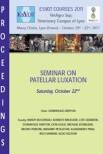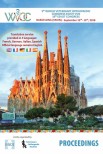Objective: To assess the reliability of computed tomography (CT) to identify the direction of implant insertion for cortical screws along the longitudinal axis of intact (nonfractured) distal sesamoid bones.
Study Design: In vitro study.
Sample Population: Cadaveric paired equine forelimbs (n=16).
Methods: Insertion of a cortical screw in lag fashion along the longitudinal axis of intact (nonfractured) distal sesamoid bones was evaluated in 2 groups (3.5 and 4.5 mm) of 8 paired limbs. In each group, the direction of the distal sesamoid bone was determined by CT (Equine XTC 3000 pQCT scanner). Screw placement was verified by specimen dissection. Implant direction was considered satisfactory if the entire screw length was within the distal sesamoid bone and not damaging the articular or flexural surfaces.
Results: In our sample and according to our criteria, the proportion of satisfactory direction of screws was 0.63 (5/8) for 4.5 mm implants, and 0.87 (7/8) for 3.5 mm implants.
Conclusions: CT is a useful imaging modality to identify anatomic landmarks for insertion of a 3.5 mm cortical screw in the distal sesamoid bone.









